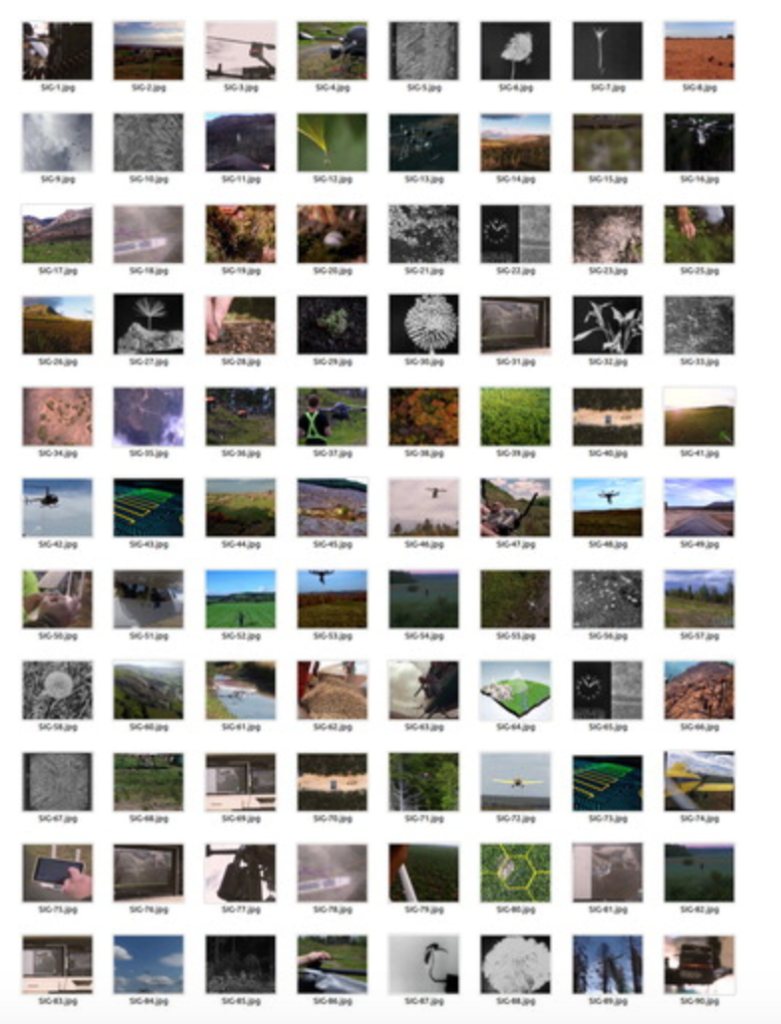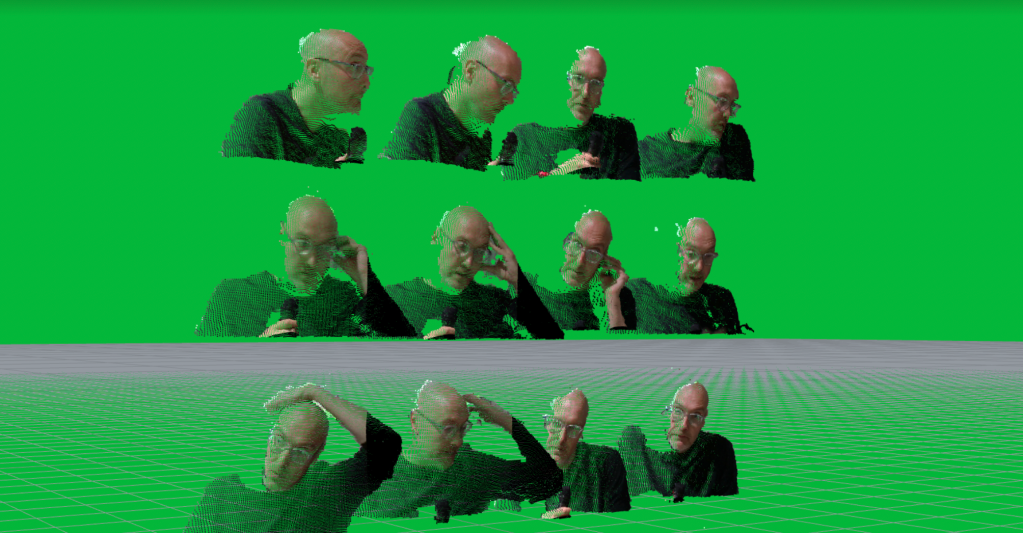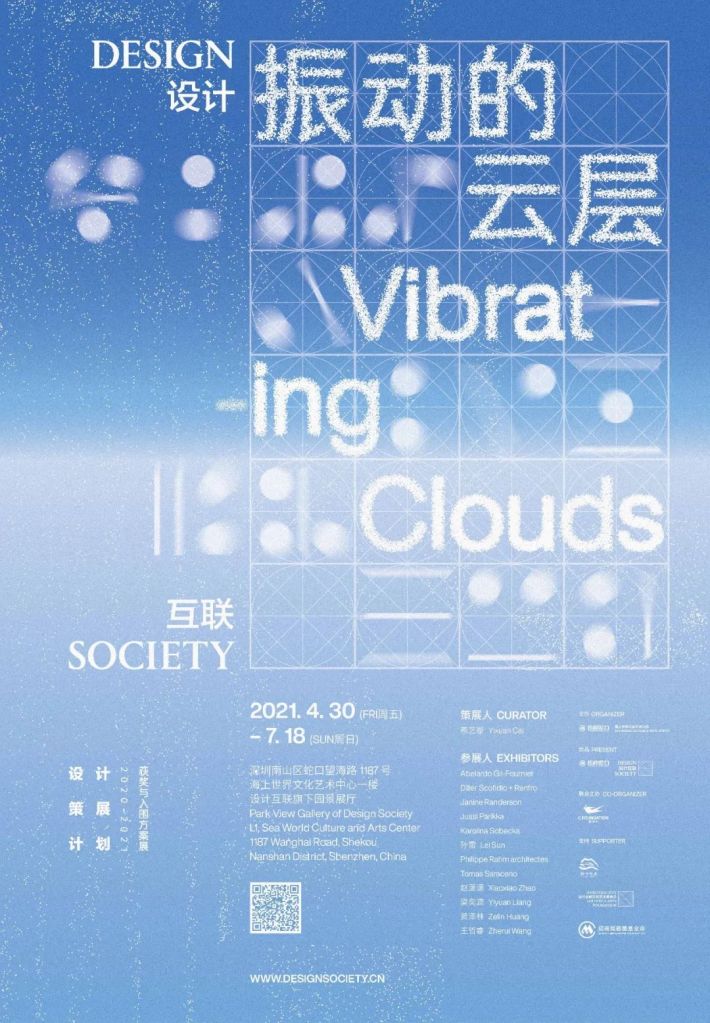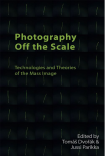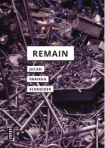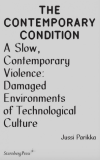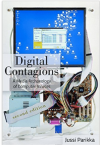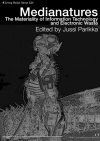Archive
First signs
First signs of Operational Images existing as a printed book.

On Practices of Images and Measures of Practice
Out in the new issue of Media Theory
“This conversation between Jane Birkin and Jussi Parikka picks up on two recently published books, Birkin’s Archive, Photography and the Language of Administration (Amsterdam University Press 2021) and Parikka’s co-edited Photography off the Scale (Edinburgh University Press, 2021, with Tomáš Dvorák). The conversation focuses on some of the media theoretical undercurrents of their two books that feature the photographic image as a central part of both their interests, while also shifting to different aspects of institutional practices of images, including questions of logistics of order and enumeration.”
Forthcoming in 2023: Operational Images
First signs of my forthcoming book Operational Images: From the Visual to the Invisual are online. Featured in the University of Minnesota Press new Spring /Summer 2023 catalogue.

An in-depth look into the transformation of visual culture and digital aesthetics
First introduced by the German filmmaker Harun Farocki, the term operational images defines the expanding field of machine vision. In this study, media theorist Jussi Parikka develops Farocki’s initial concept by considering the extent to which operational images have pervaded today’s visual culture, outlining how data technologies continue to develop and disrupt our understanding of images beyond representation.
Charting the ways that operational images have been employed throughout a variety of f ields and historical epochs, Parikka details their many roles as technologies of analysis, capture, measurement, diagramming, laboring, (machine) learning, identification, tracking, and destruction. He demonstrates how, though inextricable from issues of power and control, operational images extend their reach far beyond militaristic and colonial violence and into the realms of artificial intelligence, data, and numerous aspects of art, media, and everyday visual culture.
Serving as an extensive guide to a key concept in contemporary art, design, and media theory, Operational Images explores the implications of machine vision and the limits of human agency. Through a wealth of case studies highlighting the areas where imagery and data intersect, this book gives unprecedented insight into the ever-evolving world of posthuman visuality.
See here for the preface to the book.
The cover image includes a detail from Maria Constanza Ferreira’s video work.
Words of Weather out soon
As part of the Weather Engines exhibition we have edited the book Words of Weather, a glossary for terms for weather , out soon in English and Greek. Details where to order coming soon. Below a sneak peak at the wonderful roster of contributors and terms.
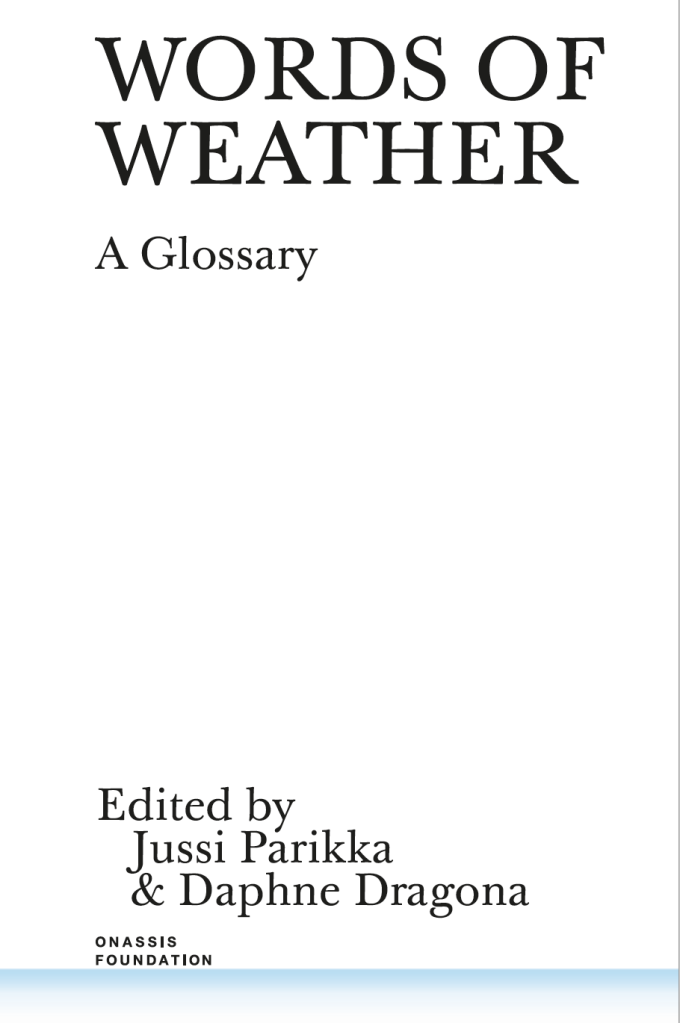
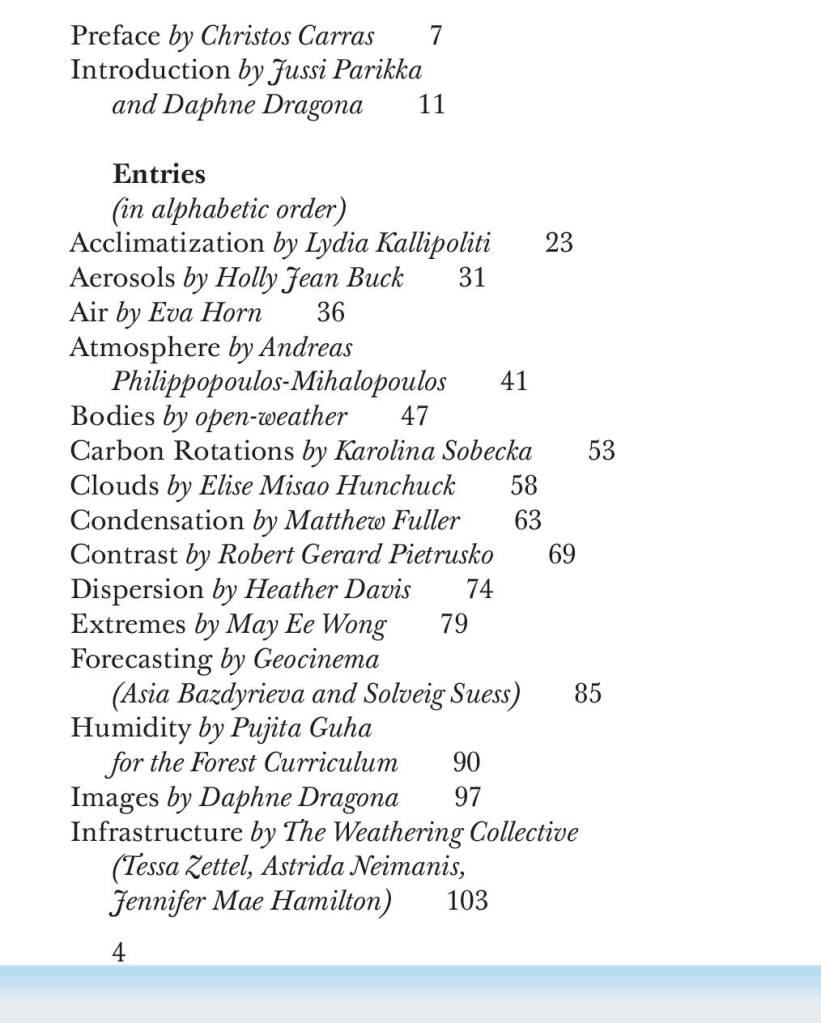
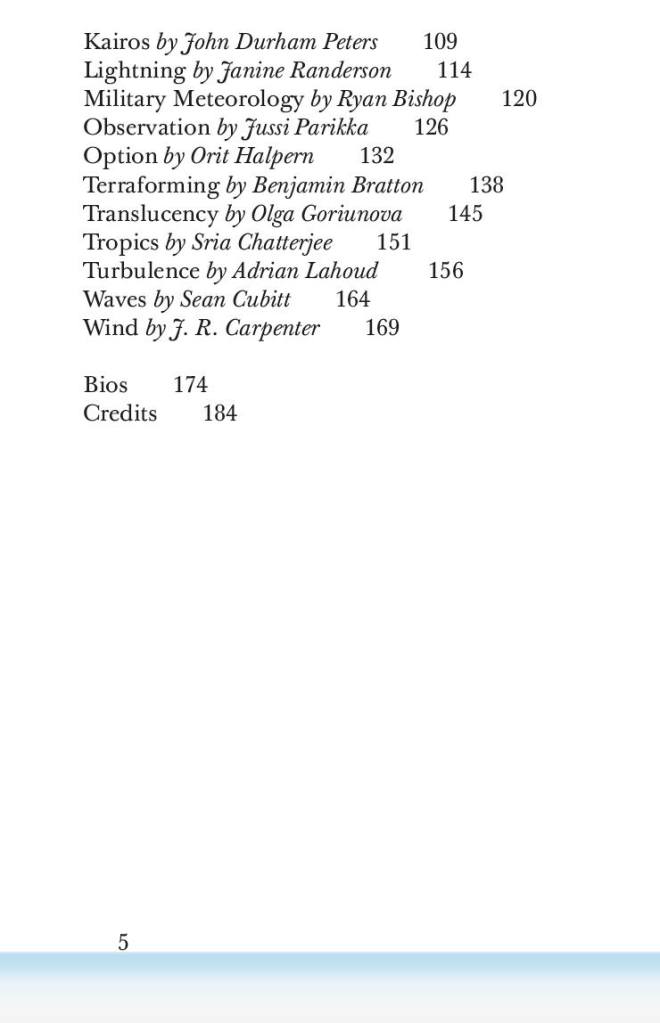
Operational Images – Preface in the forthcoming book
I submitted the manuscript for the book Operational Images (part of our project Operational Images and Visual Culture) to the publisher, University of Minnesota Press. The book is forthcoming in 2023, but for those of you interested in a sneak preview, please find below the Table of Contents and the Preface (without the endnote references though) that starts the book.
Table of Contents
Introduction: Between Light and Data
Preface: Operational Images, All the Way Down
Chapter 1: Operations of Operations
Chapter 2: What is Not an Image? On AI, Data, and Invisuality
Chapter 3: The Measurement-Image: From Photogrammetry to Planetary Surface
Chapter 4: Operational Aesthetic: Cinema for Territorial Management
Chapter 5: The Post-Lenticular City: Light into Data
Chapter 6: A Soft Montage of Operations
Preface: Operational Images All the Way Down
This book focuses on operational images, a concept that first emerged in Harun Farocki’s audiovisual work (films and video installations) and writings. The often-voiced but almost as often insufficiently developed definition is simple, and it is already somewhat evident in the term itself: there are some images that primarily operate; they are not necessarily representational or pictorial. Operational images trouble what an image is, as far as it shifts from representational to non-representational, from the primacy of human perception of bodies, movement, and things to measurement, pattern, analysis, navigation, and more. They change the scales and terms of reference. Such images have an epistemic force, while they also are involved in an intervention in the world, whether directly or indirectly. These sorts of images fix epistemic details, but while they hold them in place, they also are mobile in ways that become an essential part of their institutional activity. These points are explored in the pages that follow.
Operational images appear most often in discussions of machine vision and automation of perception, where images are part of a broader system of analysis, identification, tracking, and destruction. The term operational image seemed to speak directly to the period from, roughly, the first Gulf War in 1990 to the current phase of military and security management of territories with drones as part of an ecology of observation, analysis, and surveillance. Even a brief survey of Farocki’s films and existing literature reveals these thirty years of militarized airspace and technological systems that incorporated much of the already existing logic of targeting would be a straightforward implication of the term. However, this is not to say that this book is primarily about war or airspace, or surveillance or drones–even if such are central parts of the theme that admittedly ranges much further in the past than just the context of smart weapons and machine-readability of landscapes, territories, and objects (including people). It was also not the sole interest in Farocki’s work, especially if we consider how, for him, operational images emerged in architectural modeling, traffic control systems, construction of affective environments such as malls, and other examples that have also paved the way toward current topics of AI culture. Furthermore, this book is also not merely about a particular class of images that emerge in high-tech contexts, even if, again admittedly, it is about visual culture and its transformation into invisual data culture. We are not seeking an aesthetics or politics of digital images. There are plenty of books on these topics already, and many of them are consulted and discussed in this one, too. Thus, there is no need to write yet another take on digital visuality or digital images, or perhaps even about visual culture.
This book is about a needed shift in emphasis to the operational image. From a discussion of the image, its particular formats, and even its functions, we move to a different, albeit closely related question that concerns operations, a key term that ties to infrastructures, logistics, and all manner of actions that function to sustain, mobilize, analyze, and synthesize the thing we have grown to call “images”. I am after the coupling of perception and action, of images that control, regulate, and amplify how bodies operate.[1]
Both perception and action are terms defined in the course of this book: perception is not tied to any natural experience, optical capacity, or even a technique, and the action in question is not necessarily only the here and now of a human body but defined by more tricky causalities–including a relation to the temporality of futures, future-pasts, recursions, and more. In other words, operations do not act only on the present but across a broader timescale, including a temporalization of space (e.g., in forecasting systems).
Allow me to offer a guiding rhetorical figure that should be considered throughout this book as part of its conceptual scaffolding.[2] Operationalism is already an established term in scientific methodological literature[3], but also consider the rather famous and often overused parable of the turtle at the base of the universe. The narrative comes and goes in different forms, this one written down in Carl Sagan’s Broca’s Brain:
“Some ancient Asian cosmological views are close to the idea of an infinite regression of causes, as exemplified in the following apocryphal story: A Western traveler encountering an Oriental philosopher asks him to describe the nature of the world: “It is a great ball resting on the flat back of the world turtle.” “Ah yes, but what does the world turtle stand on?” “On the back of a still larger turtle.” “Yes, but what does he stand on?” “A very perceptive question. But it’s no use, mister; it’s turtles all the way down.”[4]“
Instead of turtles, the history of photography, technical images, and visual media could be told in the same key: instruments built upon instruments, upon infrastructures, upon practices, upon techniques, upon further instruments and infrastructures, and so on. Operations built on operations that include elements that are material and semiotic, forms of knowing, and forms of mattering. As Geoffrey Winthrop-Young points out, such turtled ontology is also shared by the cultural techniques approach in media theory, concerned with “operational sequences involving actors, things and practices that, coming together, give rise to established cultural practices.”[5] Could the same then be said about the operational sequences involving images? That there is a fundamental relational ontology at play, one that could be described by way of scaffolding operations? At the very least, we can confidently concur with Michelle Henning when she writes that “[t]he Victorian idea of the photograph as an image that makes itself no longer holds sway.”[6] This applies to the specific fantasy of unmediated images drawn by sunlight and practices of sensing and registering signals as images and diagrams.
Joseph von Fraunhofer’s 1810s invention of the spectrometer–a later backbone of remote sensing and the analysis of materials through their spectral fingerprint–represents but one case from the alternative history of visual technologies. To verify and measure the dark lines existing in the solar spectrum–later named Fraunhofer lines–the spectrometer apparatus was an assemblage of multiple elements, camera-like technologies (six lamps and a shutter), a prism, and a modified theodolite: “an ordnance surveying instrument originally designed to measure angles for the production of maps.”[7] As Susan Schuppli writes: “His work would eventually come to be used by scientists to determine the chemical composition of a remote object–our sun, some 149.6 million kilometers away–not through direct testing but by treating it as an image, one whose chromatic variance could be translated into the complex language of chemistry.”[8] Treating the world as an image beyond its pictorial qualities is one key site where operations of epistemic value take place–but there are multiple operations already in place that produce such images. Fraunhofer’s laboratory set-up can be described as an essential part of the history of science of discovery of the qualities of the solar spectrum, but as an artificial set-up of said spectrum, it is also a microcosmos of light–even of interplanetary light. It is a simulation of the behavior of solar light, too, which then introduces the possibility of using this standardized view of the dark lines on the continuity of the spectrum to scale up and down across light and materials. All sorts of material instruments and scalar operations are piled upon each other, explicated and implied.
As photography (and yet not entirely just photography), Fraunhofer’s apparatus was a camera of sorts–one built like turtles on top of each other. I would go so far as to say that Fraunhofer’s apparatus represents one central instance of the history of operational imaging vis a vis remote sensing[9] and that what was captured was not a picture in the traditional sense but a microcosmos (or a condensation of its visual characteristics) through a detailed concrete arrangement that facilitated this diagram of the abstraction to emerge, and it demanded a precise need for accuracy in the placement of angles and distances, a measurement-operation in its own right.[10]
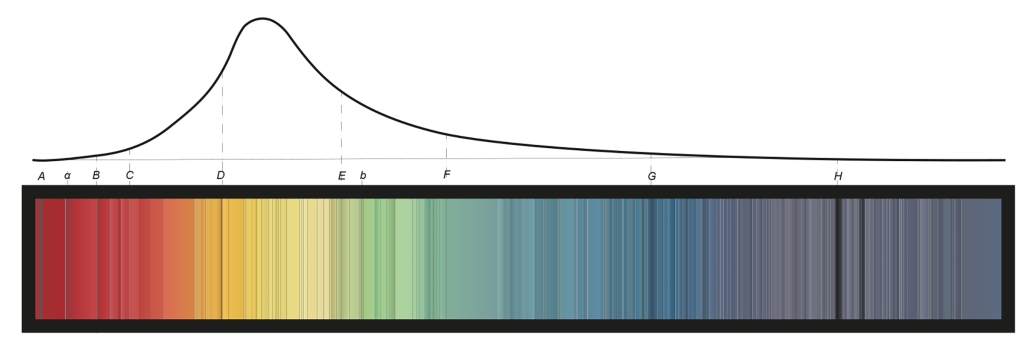
The recursive world of turtles and their relations–or camera-like instruments in laboratories and solar light–is a helpful figure of thought. At the same time, a more conceptual reference point for such operative chains of support is likely to be found in the theoretical work of cultural techniques and operative ontologies. But more on that later.
To answer the question that likely has emerged, what is this book about? It is not about turtles, but operations all the way down: images that exist only because of other operations–and the operations that help us to understand the transformation of images from visual to data. One could justifiably argue this point about cinema already, as Thomas Elsaesser speculates about Farocki’s interest in simulations as not a replacement of reality but a chain of synthesis–“the downward spiral of simulation of a simulation of a simulation”[11]–that pertains to cinema and post-cinema. In our case, we instead place emphasis on the operational transformation of the link between visuality, photography, spectral analysis, and data–a transformation that did not happen with digital culture, but circa 1900, as the story that follows will show you.

The Lab and the Field, the Image and the Instrument
I was kindly commissioned this short text about Su Yu Hsin’s frame of reference video installation at the Alexander Levy gallery (Berlin). Originally published by the gallery, here’s the text below as well alongside links to the work.
See here for the Online viewing gallery.
The Lab and the Field, the Image and the Instrument
Su Yu Hsin’s frame of reference (I and II) consists of images about images. The recursive story of environmental data offers a literal frame of reference about images that are captured in multiple windows. These moving images are nested inside other moving images. This assembly of views – scientists in action, rivers in flow, aerial views, simulations, and graphs – comes out of a patchwork of instruments of sensing that also have be nested somewhere on the field in order to transport data somewhere else. Not that the field, the lab, and data are considered separate. Any situated knowledge does not imply stand-point stability but the existence of relations, vectors of movement, and the painstaking work of trying to think what scales, what does not. Questions of proximity and distance become reversed so that any objective set of views cannot start as uninvolved distance. Instead, they have to share a terrain and be somewhere, sometime, and for some duration. The intimacy of scientific practice can be breath-taking.
These are some of the visual dilemmas of the Anthropocene landscapes that are not modelled anymore based on the genre of the landscape painting but abstract art: intensities of color, variation, and pattern that become epistemically meaningful for specialist analysis.
The composition of carefully crafted scenes is cinema about instruments. The scenes could be narrated as featuring scientific practice but there’s more at play as you can imagine. It is not that frame of reference is only about scientific practice of measurement and the critical zone of life that covers the planet but that the images become instruments that start to compose the space they are in. They are involved. They are based on but also feed forward observations.
These involved observations are, as Su Yu Hsin tells us, on the ground as the surface layer of life, but they are also off the ground; these spaces are seen through the capacity of the instruments which allow the space to lift from a specific place onto a (data) server across the planetary surface. Instruments that specify place, images that are composed in that space, and yet data that is circulating much beyond those locations. Planetary sensing, and planetary circulation of data are tightly interlinked.
frame of reference is a story of patchy images: particular views in particular time, composed and stitched together after being captured. At this particular time a certain strength wind was passing through this landscape. This patchiness is not mere limitation, but a condition of their own existence as partial views to any site and sight. It is only through the dynamic patchiness of any landscape, field, and observation that a pattern can be spotted; a systemic property determined by a heterogeneous ground.
Gradually, live shots make way for data-views; lidar imaging, simulations, satellite sensing and more. Any view taken is taken twice: first as moving images, then as moving data; first as recording of light and other signals, then as model and simulation composed of those signals. The proliferation of patchy images also makes us realise the change in what sort of images we are watching.
Change and flow are one example of the patches in motion, concretely visible on the image surfaces in Su Yu Hsin’s work. The centrality of flowing water as well as submerged views is one indication of circulation too. Any location of a patch is not necessarily contained by its site of observation and the hydropoetic moving images in frame of reference make a point about this aspect of knowing through means of aesthetics. None of this is about a stable thing but a process of composition: a river flow, atmospheric chemistry, soil composition, landscape migration. Only the scales of composition and change vary.
On the ground, in the air, and under water; the images are involved in the elemental mix. The environment is one of material capacity to be sensed as well as already sensing. Su Yu Hsin captures the double-aspect why we are drawn to it: the epistemic and the aesthetic as the two sides why a surface measurement of the Earth can become both data and sensation, measurement and affect. As such, the videos exhibited could easily be seen as perfect illustrations of the past years of art and science work with a special attention being paid to the posthumanities of environmental scales, the material agency of not only the scientists but also the landscapes, and the intensive site of the field that is immanent to the lab also the voice-over speaks of.
But more than illustration, frame of reference becomes a collaborator in all of those endeavours; alongside the field, the lab, and the database, also the image and the studio, the frame and its aesthetic references as a site of participation.
Further reading:
Horton, Zachary (2021) The Cosmic Zoom. Scale, Knowledge, and Mediation. Chicago: University of Chicago Press.
Lowenhaupt Tsing, Anna; Mathews, Andrew S., and Bubandt Nils (2019) “Patchy Anthropocene: Landscape Structure, Multispecies History, and the Retooling of Anthropology” Current Anthropology Volume 60, Number S20, https://www.journals.uchicago.edu/doi/full/10.1086/703391
Lost Islands
Lost Islands, a performance project by Samir Bhowmik (and co-choreography by Esete Sutinen) is on now at the Helsinki Biennial. Book your place if in Helsinki, but have a look at the trailer video for a glimpse of the themes: anthropocene, infrastructure, architecture, etc.
“Lost Islands is a series of expeditions tracing the route of an imaginary subterranean and underwater cable through the island of Vallisaari, with the artist serving as tour guide and narrator. The expeditions venture into the island’s topography, forested pathways, waterways, historical buildings, ruins and bunkers. Along the way, visitors are engaged and immersed in installations, film, theatre, contemporary dance, song, and experimental music. The expeditions will take place as a series of events staged on the island from June to August.”
For more info on the work and credits, see also https://helsinkibiennaali.fi/en/artist/samir-bhowmik/ .
An ecoaesthetic of vegetal surfaces
“An ecoaesthetic of vegetal surfaces: on Seed, Image, Ground as soft montage” is the title of the new article we just published in the Journal of Visual Art Practice with Abelardo Gil-Fournier. It draws on the video essay published last year and engages especially with the practice-led methodology. The video was just recently installed in the Vibrating Clouds exhibition in Shenzen and will be part of at least two exhibitions in later 2021/2022 (in Europe). With Abelardo, we are currently writing a book on vegetal images and the question of multi-scalar planetary surfaces.
Below a short excerpt of the article’s Introduction section
—
This essay builds on our recent Seed, Image, Ground video project (2020) and how it entangles with our larger research project on surfaces. Both address the surface of plants, agriculture and the biosphere in relation to the surfaces of media, such as screens and images. The video essay was commissioned by the Fotomuseum Winterthur in 2020 and it is openly available at the institution’s YouTube channel. While the video is a central reference point for this visual essay, our aim is not so much to theorise our own moving images and their juxtapositions and rhythms. Instead, in this article, we present a series of surfaces and scales that appear in and through the images. Images build upon images and this constitutes the practice-led approach to the temporal unfolding in the video. The video works as a temporal articulation of image surfaces across and upon living surfaces. In other words, we articulate the moving images as practices of surfaces, plants, and images: hence the central motif of the video essay and this accompanying text is to ask ‘what do images of growth look like?’ How do such images operate in two channel video practice that builds on Harun Farocki’s work? Here, we do not refer only to operational images (Farocki 2004), but also to the idea of a ‘soft montage’ (Farocki 2009) which becomes a methodological reference point as one aspect of practice of images about and across images that can also be conceptualised as we do in this essay. The video and its relation to text are ecoaesthetic (Cubitt 2017) in the sense of dealing with the entanglement of media and environmental materials where the double articulation of images and green plant surfaces are the engine of our argument.
In this way, the video is a methodological exercise that helps to articulate a problem space (Lury 2021) – a space where problems, methods, and concepts are dynamically rearticulated, and where the space of their composition is not a stable container where a thing is addressed but part of their making: ‘a problem is not given but emerges with-in and out-with a myriad sequence of actions or methods that (trans)forms the problem space’ (Lury 2021, 6). This composition and this montage points to the ways methods are enacted only in the material practices that constitute the problem space as it unfolds as a living issue and tissue. Can this sequence Lury refers to be also a sequence of images? Could the actions be those of images? As the following visualisation of the evolution of the timeline of our video essay show, the video’s timeline as a problem space presents its fabrication as a surface. The cuts, the movements of the sequences, and other editing operations manifested in the figure, call for a dynamic understanding of surface as surfacing, built on multiple genealogies of instrumentation, technology, and cultivation.
